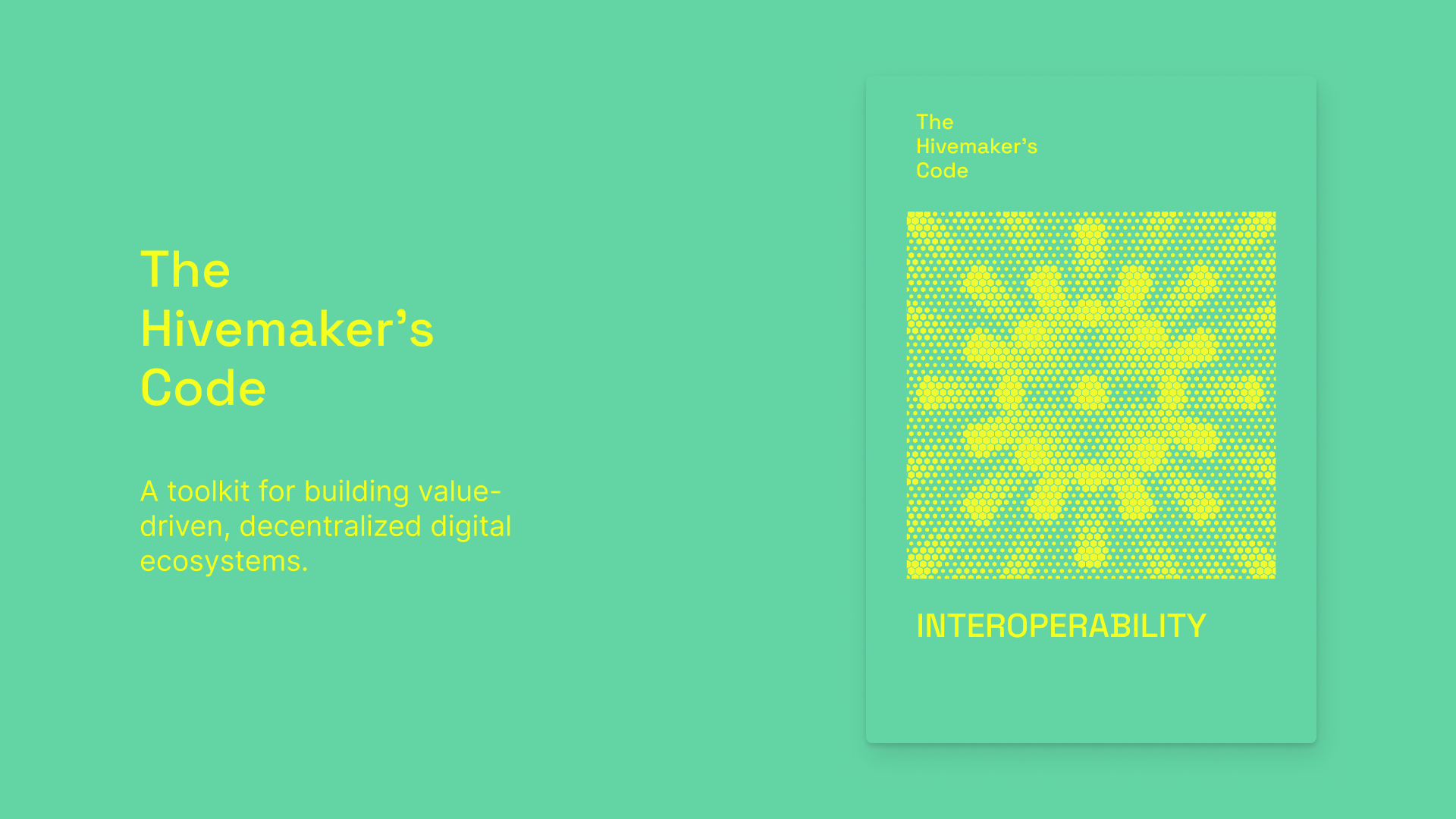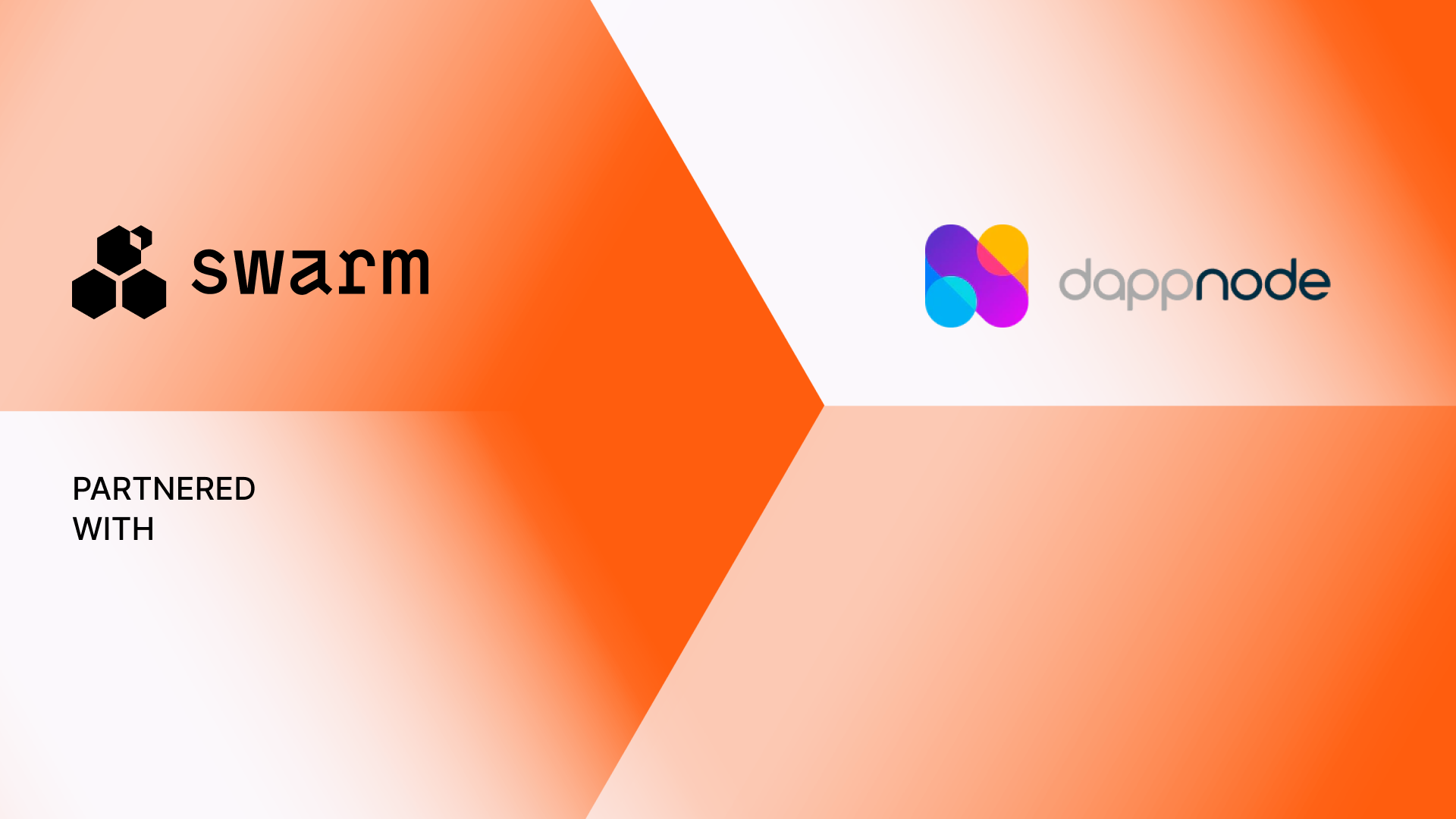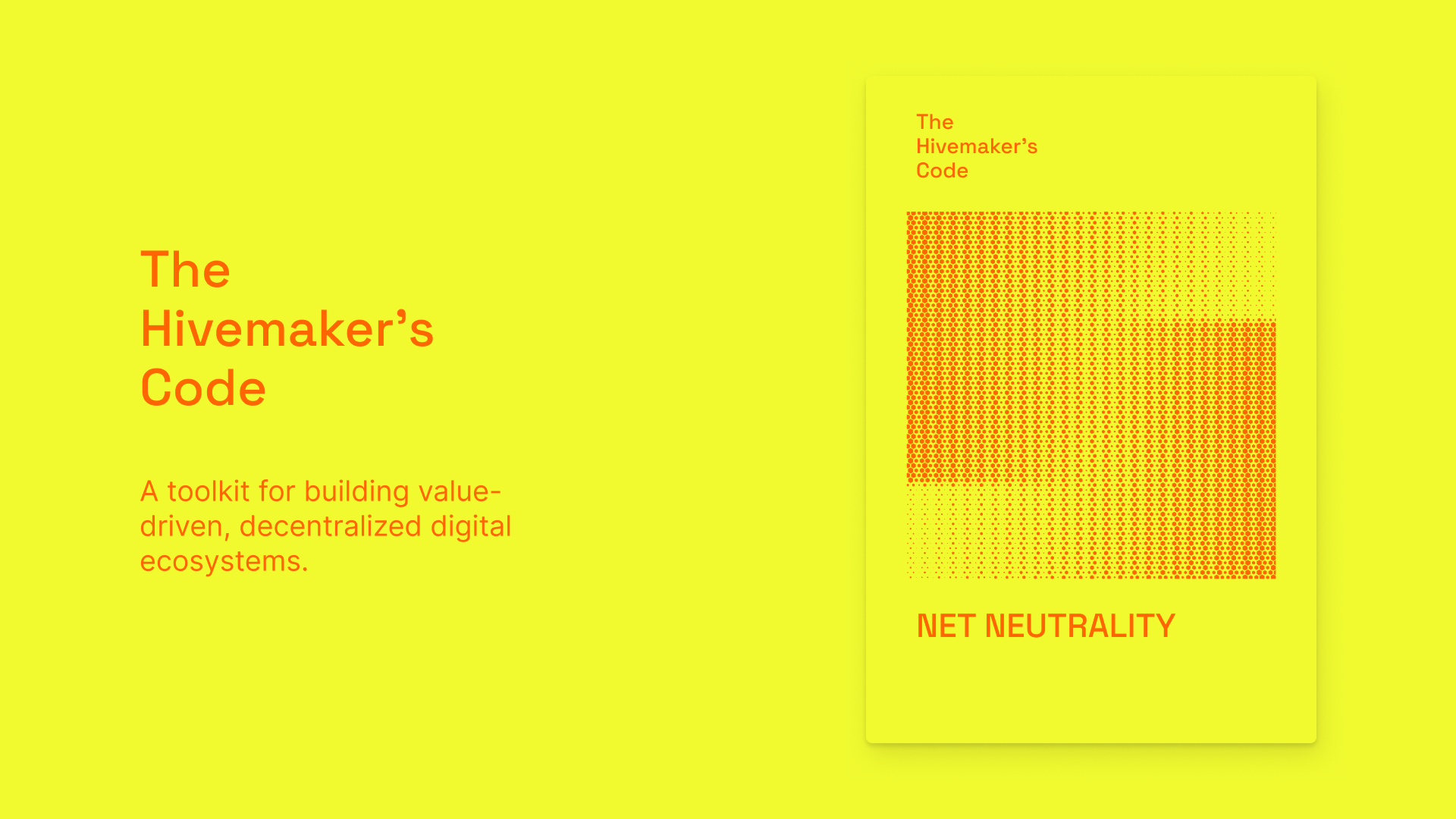This article is part of The Hivemaker’s Code series:
- Article 1: Introduction
- Article 2: How do Ecosystems Grow?
- Article 3: Cooperating on Blockchain
- Article 4: The Satoshi’s Dream
- Article 5: Anonymity in the Cryptosphere
- Article 6: Democracy and Decentralization
- Article 7: Is Net Neutrality Important for Blockchains?
- Article 8: Why Interoperability is the Bedrock of Digital Freedom
- Article 9: The Way Forward
Authors: Oliver Lukitsch, Michal Matlon, Gregor Žavcer, Thomas Fundneider, Markus Peschl, Lena Müller-Naendrup
Why Interoperability is the Bedrock of Digital Freedom

The European Union is a remarkable project granting us many freedoms so convenient it’s all too easy to take them for granted. We can easily move our goods, our bucks, and ourselves between different countries within it. This freedom to move and provide services anywhere is the cornerstone of the democratic and open way of life and economy in Europe.
When we use the internet, we often don’t think about freedom. We may create and store our data on one platform, but it’s often stuck in one place and cannot be easily moved. This is called “data silos” - platforms and ecosystems that keep their information within their own network and limit what their users can or cannot do with it.
The solution to this problem is called “data interoperability.” It refers to the possibility of sharing information and data without losing or having to change any part of it, even when shared between different platforms and systems.
For many of us, data interoperability sounds abstract and might not be a concern. But have you ever played a video game, got a new console, and couldn’t seamlessly transition to playing it on the new platform while keeping your saves and progress? Then you know how it feels to suffer from diminished interoperability.
Or you are using Signal as a messenger with most of your friends, but two folks only use Telegram. Your bad. You have just been the victim of poor interoperability again. But if you are a Gmail user and send a message to a Yahoo account, that’s not a problem. You just experienced the bliss of data interoperability.
As you can see, data interoperability is deeply useful. But it is not just a matter of usability. It is also a matter of digital freedom and control – a matter of digital agency and self-sovereignty.
Data Interoperability is Necessary for a Vital Web3
 We already know that legal and technical data ownership is paramount to the mindset of a blockchain-based web – we have covered this aspect in our other articles.
We already know that legal and technical data ownership is paramount to the mindset of a blockchain-based web – we have covered this aspect in our other articles.
However, data ownership is only one side of the coin of safeguarding fully-fledged data sovereignty. We can distinguish between data ownership and data agency. While the first denotes the idea that you are the owner of your data, the second means that you can also decide what the user can do_ _with it. Hence, while you can have one without the other, the idea of a sovereign Web3 combines these two concepts.
A final benefit of Interoperability is that it can be an asset for knowledge ecosystems and can foster the creation of novel ideas and innovation. Think of the biological mechanism of crossbreeding or interbreeding. By exchanging genetic information across different subspecies, you can give rise to new ones.
To summarize, interoperability matters and unfolds its benefits on three different levels:
- Usability
- Data sovereignty
- Knowledge creation
We shall now delve into these three topics in more detail.
1. Usability

It is easy to see why interoperability is user-friendly. Just imagine how you can move your crypto assets freely between various DApps or entire blockchain ecosystems. Imagine a future blockchain metaverse in which you can move crypto art from one digital real estate to another.
Or you might have earned an NFT in a blockchain game and want to use it outside of the game in which you earned it. You might also want to pay for some crypto asset embedded in another blockchain ecosystem with a cryptocurrency that is not native to this ecosystem. Moreover, with the rise of IoT ecosystems, there must be reliable and secure interfaces between them.
All these things require interoperability. And all things considered, data interoperability increases the usability of entire ecosystems by enabling the free flow of information and data between them. The increase in usability is thus an increase in the user’s ability to move data or communicate across ecosystems - preventing vendor lock-in.
Interoperability of Different Blockchains
Increasing usability must be carefully weighed against security concerns. This is especially relevant for the interoperability between different blockchains. While a single blockchain and its protocols safeguard its user’s privacy and security, a cross-chain token transfer is a somewhat predetermined breaking point of the security web. A reason for this is the lack of a distributed consensus mechanism that applies only to transactions within a blockchain network_ _but not between two distinct blockchains.
Interoperability is a challenge to implement. It’s sometimes called the “interoperability trilemma” (not to be confused with the so-called blockchain trilemma).
A blockchain’s interoperability features cannot satisfy its security, extensibility (scalability or speed), and data agnosticism (its universal application across any blockchain) simultaneously. An ideal blockchain bridge would work for and across every blockchain and be fast, trustless, and secure:
- Secure / trustless: trustless requirements beyond the underlying blockchains’ requirements.
- Extensibility / speed: low communication latency between blockchains.
- Data Agnostic: the architecture’s capacity to be easily modified and integrated on a new blockchain.
2. Data Sovereignty

To promote data sovereignty, interoperability is essential to maintain control over personal data and is, therefore, as important as data ownership. Only when users are able to move their data freely and without restrictions can the benefits of data ownership be fully realized.
Today, users have little control over their personal data. However, particularly in Europe, data protection policies have evolved positively, at least to some extent, including the introduction of the General Data Protection Regulation.
But while users’ rights have improved, the big social media companies still control personal data in increasingly subtle ways. Users are often encouraged to stay within a single ecosystem, making it difficult for them to move their personal data freely. This restriction directly affects the interoperability of personal data and limits user control.
For the big tech companies, this may be an economic measure to protect their own ecosystems from the competition. But it does not bode well for users. Social media platforms, cloud and IoT services are in the hands of a small number of companies protecting their oligopoly - and that means sacrificing interoperability to keep their customers in line.
You might ask whether staying in a closed ecosystem can be beneficial to the user. Think Apple products, which work great but often undermine data interoperability and cross-platform functionality. But interoperability is not only a usability issue; it is also a policy issue.
This is a very timely issue: European legislators are aware of the need to set policy, as reflected in the EU’s Digital Marketing Act (DMA). Large technology companies are seen as gatekeepers with overly concentrated power in the market, disenfranchising smaller players at the expense of user freedom and choice. The DMA aims to achieve its goals by forcing large companies to enable data interoperability and portability for their users, thereby creating conditions for fair competition and platform innovation.
In summary, by ignoring the need for interoperability, users are disempowering themselves and giving more power to the big technology companies that manage our data. In doing so, they are providing these companies with a very valuable asset, our personal data, and they are doing so without making them pay a fair price.
Unionizing Data Vending
Ownership of personal data can be used as leverage to empower users. If users know what their data is worth and if they really own and control it, they can also influence the price that an interested party has to pay for its acquisition.
In this context, the interoperability of data is a necessary prerequisite for personal data to be used as leverage and a commodity by their original owners. In other words, to be able to sell and withhold personal data in a value-conscious manner, the user must also be able to control it.
Interoperability opens up different pathways across platforms and ecosystems, and thus the possibility of exercising control over your own data. For example, if you don’t like Facebook having your data, you need to be able to take your personal data stored on the platform and use it elsewhere without losing the function of the data.
Interoperability is Not an End in Itself
A final note on the bigger picture: interoperability alone is not enough to achieve data sovereignty and user empowerment. In fact, some large IT companies want to increase interoperability between different ecosystems. That is, they are aware of the usability value of interoperable ecosystems.
Data interoperability greatly increases the viability of IoT devices, such as smart sensors, that can communicate in an interoperable environment across ecosystems from different companies. Just consider “Matter”, a new smart home standard that allows devices from Apple, Google, Amazon, and Samsung to communicate across their respective ecosystems.
While this is a positive development for the usability of smart devices, it does not give users full control over their personal data. Rather, the involved companies provide the consumer with another argument to cease ownership once again.
In a Web3 environment that delivers on its promise, interoperability is not an end in itself but a means to promote data sovereignty and empower users to decide where their (self-owned) data is stored.
3. Knowledge Creation

One of the ways that interoperability is being standardized today is the so-called “European Interoperability Framework.” It does not only apply to digital ecosystems but to any kind of infrastructure that is not harmonized across the EU.
Take the European railway system. For a train to travel from Paris to Warsaw, it has to comply with different and sometimes conflicting national standards - technical, legal, organizational, and semantic ones.
For example, railcars of different national railway services must match, and their digital systems must be able to communicate with one another. Otherwise, signals must be translated and interpreted correctly.
Simply put, interoperability involves an agreement on the harmonization of the meaning of things that cut across the boundaries of distinct ecosystems. In the context of Web3, this means that the function and value of a token must retain its meaning for the users even upon being moved across different platforms.
Thus, the primary function of data interoperability is to preserve the meaning and functionality of data.
In the context of blockchain platforms and ecosystems, data interoperability can be seen as the interoperability that enables tokens to be used across platforms. To give an example: Using Swarm as a decentralized data storage platform, companies could upload and download data related to their products and services. This would allow consumers to select their order on a DApp.
The DApp uploads your chosen menu items to Swarm, generating a unique code for the order. The cashier then accesses the order code with their own DApp, which downloads the data from Swarm and translates it into a list of orders to be processed and served. This is a notable case of interoperability as two distinct DApps can communicate and agree on the same reference codes for products.
The Meaning of a Token
In many cases, however, we can expect the meaning of data to change as the context of its blockchain environment changes.
For example, the way crypto tokens are used and issued, and what can be done with them, is very different between the Bitcoin blockchain and Ethereum. If it were possible to move your Bitcoin wallet to Ethereum, you would be storing your Bitcoins in a completely different environment, potentially creating new forms of use and thus changing the meaning of Bitcoin tokens altogether.
To provide you with an example of how strongly the meaning of a “semantic object” can change when its contextual framework changes, just consider what historians have called “scientific revolutions.”
The historian Thomas Kuhn observed that scientific systems do not grow indefinitely but rather collapse at some point when their limits become apparent and progress halts. Sometimes, this is when a new generation of scientists takes over and introduces a new paradigm - a new framework that radically restructures the beliefs and premises previously held by a scientific community.
Scientific revolutions involve the radical transformation of meaning (semantics) while the vehicle of the meaning (the sign or symbol) is retained. So while you can use the linguistic symbol “mass” in both Newtonian and Einsteinian physics, it has a radically different meaning across these two scientific frameworks – meaning that “mass” has an entirely different meaning before and after a scientific revolution.
This shows how a symbol, such as a token moved across different blockchain ecosystems, can change (its meaning) as it shifts its context or knowledge framework.
As different blockchain ecosystems also have varying beliefs about the future of the economy, modalities of social interaction, or the potential of consensus mechanisms, any transfer of an ecosystem’s native tokens to another ecosystem has transformative power.
While of course, this is only possible if we accept that the meaning of a token might change, sometimes fundamentally, it is critically important for ecosystems that are designed to be nimble, agile, and open to transformation.
Living Ecosystems Must Interbreed
Another argument for this type of interoperability without meaning-conservation is that it is critical for the vitality of an ecosystem. So let us first turn to a biological metaphor.
By exchanging data between different platforms and ecosystems, you can foster a process of “interbreeding.” External information intrudes a relatively closed system, thereby leading to a reciprocal change of the system and the newly introduced information.
For living beings and biological ecosystems, such externally-induced “shake-ups,” often called “perturbations”, are essential for reproductive fitness. New genetic information introduces new potentials, which allow the ecosystem to change course and nest in new niches by realizing such potentials.
The ability to get “perturbed” by an external impulse attests to an ecosystem’s vitality and “alive-ness.” After all, it is a fundamental property of life that it can radically transform and bring forth new forms of being and niches. You could thus say that the “interoperability”of biological ecosystems, their ability to exchange genetic material, is critical for their ability to change, grow, and survive.
In other words, if you want your DApps and crypto-platforms to thrive and feel alive, they must be interoperable and permeable. We can set free a vast potential by allowing DApps, blockchain platforms, and ecosystems to interact openly with one another. It is key to the essential value proposition of Web3: the creation of a network in which users take ownership of and assume agency over their data.
Interoperability not only vastly increases the usability of DApps and control over our own data. It also unleashes the innovative potential inherent to such systems by allowing them to interact both seamlessly and creatively. It is something any decentralized ecosystem should strive for, especially if they bet on their vitality and self-sustainability.
Key insights

- Data interoperability increases the usability of blockchain applications by allowing data exchange across different platforms and ecosystems
- Data interoperability—if done right—increases our control over personal data
- Interoperability has to be realized on a technical, semantic, organizational, and legal level
- Semantic interoperability is key for basic forms of interoperability by allowing the meaning of tokens to remain altered upon transferral across various ecosystems
- Even if the meaning of a token does not remain constant upon transferral, cross-platform token-exchanges can be positively disrupted, driving innovation and meaningful change.
References

- Bhuptani, Arjun. 2022. “The Interoperability Trilemma.” Medium. February 28, 2022. https://blog.connext.network/the-interoperability-trilemma-657c2cf69f17.
- “Blockchain Interoperability: Challenges & Opportunities | NGRAVE.” n.d. Accessed November 21, 2022. https://www.ngrave.io/en/blog/blockchain-interoperability-challenges-opportunities.
- Schulte, Stefan, Marten Sigwart, Philipp Frauenthaler, and Michael Borkowski. 2019. “Towards Blockchain Interoperability.” In Business Process Management: Blockchain and Central and Eastern Europe Forum, edited by Claudio Di Ciccio, Renata Gabryelczyk, Luciano García-Bañuelos, Tomislav Hernaus, Rick Hull, Mojca Indihar Štemberger, Andrea Kő, and Mark Staples, 3–10. Lecture Notes in Business Information Processing. Cham: Springer International Publishing. https://doi.org/10.1007/978-3-030-30429-4_1.
- Ström, Timothy Erik. 2022. “Capital and Cybernetics.” New Left Review, no. 135 (June): 23–41.
- “What Is Blockchain Interoperability?” n.d. Accessed November 21, 2022. https://lisk.com/blog/learning/what-blockchain-interoperability.
Discussions about Swarm can be found on Reddit.
All tech support and other channels have moved to Discord!
Please feel free to reach out via info@ethswarm.org
Join the newsletter! .




